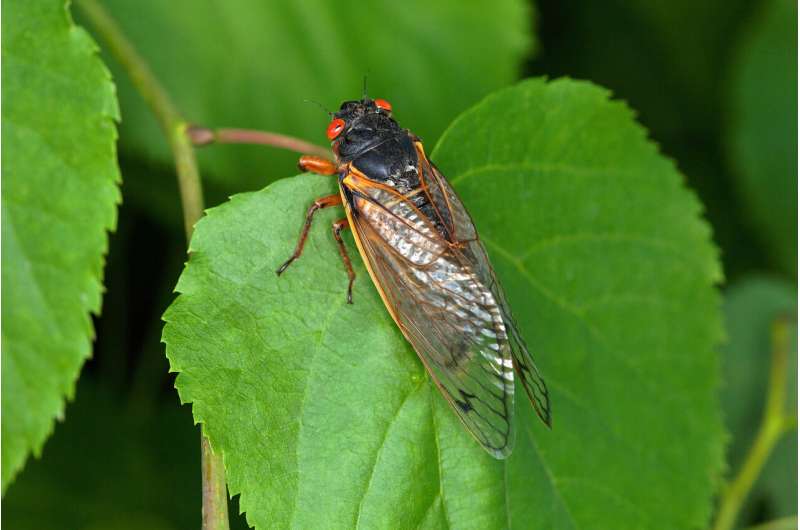This article has been reviewed according to Science X's editorial process and policies. Editors have highlighted the following attributes while ensuring the content's credibility:
fact-checked
trusted source
proofread
Do adult periodical cicadas actually feed on anything?

Every so often, cicadas emerge above ground and blanket the Earth with their exoskeletons while emitting a high-pitched chirp from sunrise to sunset. The periodical cicadas in the genus Magicicada come every 13 or 17 years, though other types of cicadas emerge much more frequently in our neighborhoods.
A long-standing agricultural query related to the periodical cicadas was recently answered by an Agricultural Research Service (USDA-ARS) research team at West Virginia's Appalachian Fruit Research Station. Simply: Once periodical cicadas emerge, do they actually feed on vegetation?
Magicicada pose a threat to U.S. agriculture due to their ability to damage orchard trees when they lay their eggs on tree branches. Many growers and nurseries take this into consideration and refrain from planting new trees in years when periodical cicadas emerge, as their eggs can kill young trees.
ARS researchers investigated the best way to solve this agricultural challenge by reviewing the life history, reproductive biology, and evolutionary relationships of cicadas over the past 150 years. But many have often disagreed about whether, or how much, the adults feed.
This is because the needle-like mouthparts of cicadas do not leave much evidence of any feeding, unlike chewing insects, and their digestive tracts that are notoriously difficult to dissect. USDA-ARS researchers studied adult male and female Magicicada during the 2021 emergence of Brood X in Maryland, Virginia, and West Virginia as the insect moved through apple orchards and wooded public parks and residential properties.
The findings, published October 18 in the Journal of Insect Science, disrupted the age-old popular myth of adult periodical cicadas not feeding. Scientists found mainly woody plant and Malus, or apple tree DNA, in adult cicada guts and found that 54% of those cicadas contained DNA from multiple plant species.
While this strongly implies that adult Magicicada feed on plant sap, it was necessary to show that the recovered plant DNA was not just leftovers from meals eaten during the nymph stage.
"We tested teneral adults, or brand new adult Magicicada that had not had a chance to feed yet, to check for any leftover plant DNA," said USDA-ARS research team leader James Hepler, Ph.D. "We couldn't find any plant DNA in the guts of teneral adults, so we can be reasonably sure that the DNA found in mature adult Magicicada was eaten during the adult stage, since no DNA carries over from the nymph stage."
Cicadas appear to have highly permeable exoskeletons that permit considerable water loss and allow water to evaporate out of the insect a little easier than many other insects. Also, the presence of essential amino acid-producing endosymbionts in the gut tissues of adult Magicicada imply that, despite the water loss, some nutrition is being derived as they feed on plant species.
USDA-ARS will continue to examine the life cycle of Brood X and solve agricultural challenges directly related to their life span above ground. More studies will also be conducted to look at the impact that adult Magicicada contribute to tree physiology.
More information: James Hepler et al, Do adult Magicicada (Hemiptera: Cicadidae) feed? Historical perspectives and evidence from molecular gut content analysis, Journal of Insect Science (2023). DOI: 10.1093/jisesa/iead082
Provided by Entomological Society of America


















